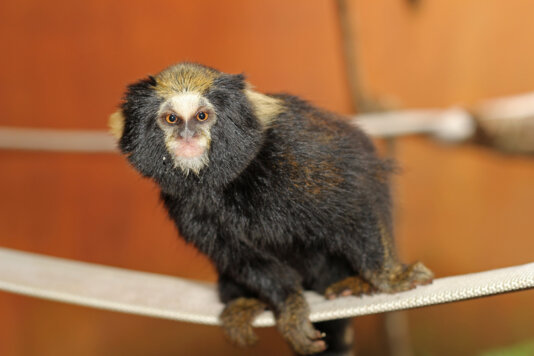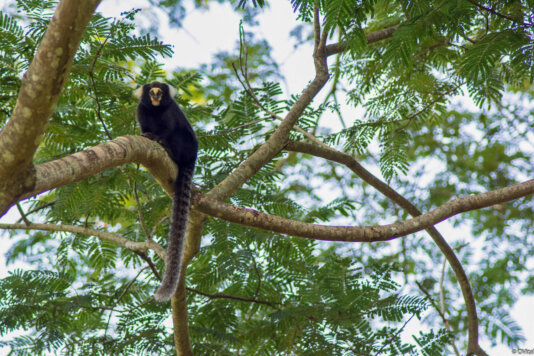- About
- Topics
- Story
- In-Depth
- Picks
- Opinion
- News
- Donate
- Signup for our newsletterOur Editors' Best Picks.Send
Read, Debate: Engage.
| November 03, 2021 | |
|---|---|
| topic: | Conservation |
| tags: | #mountain marmosets, #NGO, #Brazil, #extinction, #deforestation |
| located: | Brazil |
| by: | Ellen Nemitz |
The two species also face other threats, such as deforestation, and are on the brink of extinction.
The Mountain Marmosets Conservation Program is a Brazil-based initiative working to give marmosets a chance to thrive again. FairPlanet Spoke to Silvia Bahadian Moreira, chief conservationist at the Primatology Center of Rio de Janeiro (CPRJ), and Rodrigo Salles de Carvalho, coordinator of the Mountain Marmosets Conservation Program, about the threats facing marmosets and the attempts to protect them.
FairPlanet: What are the main characteristics of the two species of marmosets and why are they so endangered?
Silvia Bahadian Moreira: The Buffy headed marmoset and the Buffy tufted-ear marmoset are our autochthonous species in Rio de Janeiro state. They are small sized marmosets, reaching 300 or 400 grams when adults, that feed on a wide range of insects, wild fruits, tree gum. They live in families formed by a couple and their offspring, typically in a high altitude forest - usually above 600 to 700 meters above sea level. Originally in Rio de Janeiro State, the small primate that occurs in forests at sea level is the golden lion tamarin.
Rodrigo Salles de Carvalho: The fragmentation of the Atlantic Forest is a problem affecting all primates. Nowadays, 8 to 15 percent of Atlantic Forest is still standing, depending on the viable remaining area you consider. For mountain marmosets, for example, 50 hectares is a minimum, and those areas represent 13 percent from those 15 percent, let's say, so only 2 percent of what the Atlantic Forest used to be. That was a catastrophic event for the existence of wild animals in the Atlantic Forest.
SBM: The mountain marmosets are subjected to all the pressures that all other primates are. In addition to a huge reduction of high-quality forests to support them, there is no connection between these fragments of the forest, which makes the animals genetically isolated, leading to a degenerative process. Eventually, they could disappear.
Another threat was the introduction of different species of marmoset that became invasive in the southeast. Between the 1950s and 1970s, people used to traffic marmoset species from the Northeast, especially the common marmoset (Callithrix jacchus), to other regions. In the state of Minas Gerais, São Paulo and Rio de Janeiro, these animals were eventually released by uninformed inspectors or even by the people who once bought them, or because they escaped. So we had a colonisation of these invasive species, which reproduce very fast and compete for the habitat, for food and even for reproductive partners.
Nowadays, there is a big hybrid population in the Southeast. In Rio de Janeiro, for instance, it is very common to see them walking on the energy cables. They tolerate humans, while the Buffy headed marmoset and the Buffy tufted-ear marmoset do not, are fed by people and then thrive among them. In the long term, if nothing is done, the mountain marmoset will be genetically lost.
Is there a solution to this problem?
RSC: Combating invasive species is a global and very difficult problem. During the Primatology Congress in 2017, we discussed and decided to save the mountain marmosets by protecting areas where they are still native, not hybrid, and also through captive-breeding programmes.
SBM: In fact, combatting an invasive species is tremendously difficult and in addition raises several challenging questions of ethical dimensions that must be considered. There is a public identification with the invasive species, making necessary direct management actions such as removal complicated even further. So we protect these areas where the mountain marmoset still exists without hybridisation and try to connect the areas in order to provide genetic exchanges.
Parallel to this, we carry out the captive-breeding programme, using a study book with all genetic records to decide how to better cross-breed. This is called a "safety population,” to be used in case we need to reintroduce it into the wild.
It is expensive because we need several different places to do it in order to guarantee genetic variety and protection against diseases and other potentially fatal events. Not all primates have a captive programme, but considering how fast we were losing the mountain marmosets, we needed to do it.
When was the Mountain Marmosets Conservation Program founded and how does it work nowadays?
RSC: The efforts regarding the Callithrix aurita and the Callithrix flaviceps date further back than the programme itself, but the integration of researchers and institutions concerned with the species conservation and survival began in 2014 during a meeting in the Brazilian Primates Conservation Center (CPB), in Rio de Janeiro. It was during the workshop promoted by the Durrell [Wildlife Conservation Trust], a very competent institution renewed for saving species on the edge of extinction, with few remaining individuals.
SBM: They have a zoo on the channel island of Jersey in England, where the animals, including many little primates such as marmosets and lion tamarins, live in partial freedom. They invest money in recovering and conserving the threatened species, and also have a training sector. That is why they came to Brazil in 2014 to make a workshop with several professionals for small primates. Since this meeting, the discussions on how the aurita was threatened and on the edge of extinction began.
RSC: Sothe ICMBIO with their CPB initiative, along with other participating stakeholders, helped to form the MMCP, which works in conjunction with the NGO PREA in Minas Gerais State. It has been a challenge since then to gather and organise such a big and diverse group of professionals with different duties. However, nowadays we have a group of researchers and institutions integrating ideas and actions towards the conservation of the Callithrix aurita and the Callithrix flaviceps.
The team gathers almost 30 people from different parts of Brazil and also from the United Kingdom, France and Holland. Are they all volunteers?
SBM: Nearly 99.9 percent are volunteers and are employed elsewhere as professors, at zoos and other places. They dedicate part of their time to the meetings and decision-making processes driven by a personal interest, because they believe in the importance of conserving these species.
RSC: And we have one employee, who is paid through university resources, who takes care of the Mountain Marmoset Conservation Center.
What about the role played by governmental institutions, such as the Chico Mendes Institute for Biodiversity Conservation (ICMBio)?
SBM: ICMBio is the Institution responsible for defining the official guidelines for conservation (or conservationist's?) actions related to wild fauna in Brazil. Within ICMBio we have the National Center for Research and Conservation of the Brazilian Primates (CPB), which is the entity responsible for drawing up these policies, guidelines and decision-making relating to primates that are published as National Action Plans (NAP). These NAPs are drawn up together with different actors such as specialists, researchers, university professors, technicians from environmental agencies, etc. and are implemented by environmental agencies and NGOs across the country, always acting under the oversight of the CPB.
RSC: Actually, the National Center for Research and Conservation of the Brazilian Primates (CPB-ICMBio) deals with all Brazilian primates, especially the endangered ones. Considering the Atlantic Forest alone, there are 14 species, plus the Amazonian ones and species from other biomes and eco-regions. So, even though their work is amazing, they cannot do everything alone and need people to spearhead efforts with each species in particular.
The mountain marmoset is found in São Paulo, Rio de Janeiro and Minas Gerais, so it is difficult to deal with this broad distribution.
What has been done so far to map the regions and the remaining mountain marmoset populations?
RSC: In 2020, we were planning a workshop to discuss this. Due to the pandemic, the meeting ended up online. The good thing is that we managed to gather almost all the researchers involved in the conservation of the two species. We made maps with almost all the records of Callithrix flaviceps and the Callithrix aurita from 1990 until today, ranked and prioritised decisions and are in the process of identifying and selecting high priority areas for future movement of groups for repopulation, among other things.
SBM: The goal of the workshop was to gather as much information as possible, organise and systematise it, so that everyone could work based on the same methodology and the best practices. We will have a wealth of information about the ecology of the species, reliable maps of occurrences, places that need to be better studied, and we will probably create new protected areas based on the document.
We have also worked on a decision protocol concerning the invasive marmosets: when to intervene and when not to, and what kind of intervention to carry out. This can help decision-makers who are not always specialists and can feel vulnerable while deciding what to do.
What can the public do to help your conservation efforts?
RSC: Few people actually know the autochthonous mountain marmoset, because the species live inside the forest. Environmental education is, thus, the best investment we can make. Previous experiences showed us how important engaged people can be to conservation.
In Petropolis , for instance, the plight of the mountain marmosets will be part of the school curriculum. Also, Petropolis and three additional cities are creating an official day to raise awareness of their conservation, and we are working to create an unified education programme.
This is essential. If I could choose just one thing to invest in, it would be education, because children will actually change the future.
SBM: Besides that, it is important to give more visibility to the population as a whole, so that they can engage and protect the autochthonous marmoset, instead of the invasive one. People can be the protector of the two species and be proud of them.
Image by Daniel Sotto Maior.
By copying the embed code below, you agree to adhere to our republishing guidelines.


